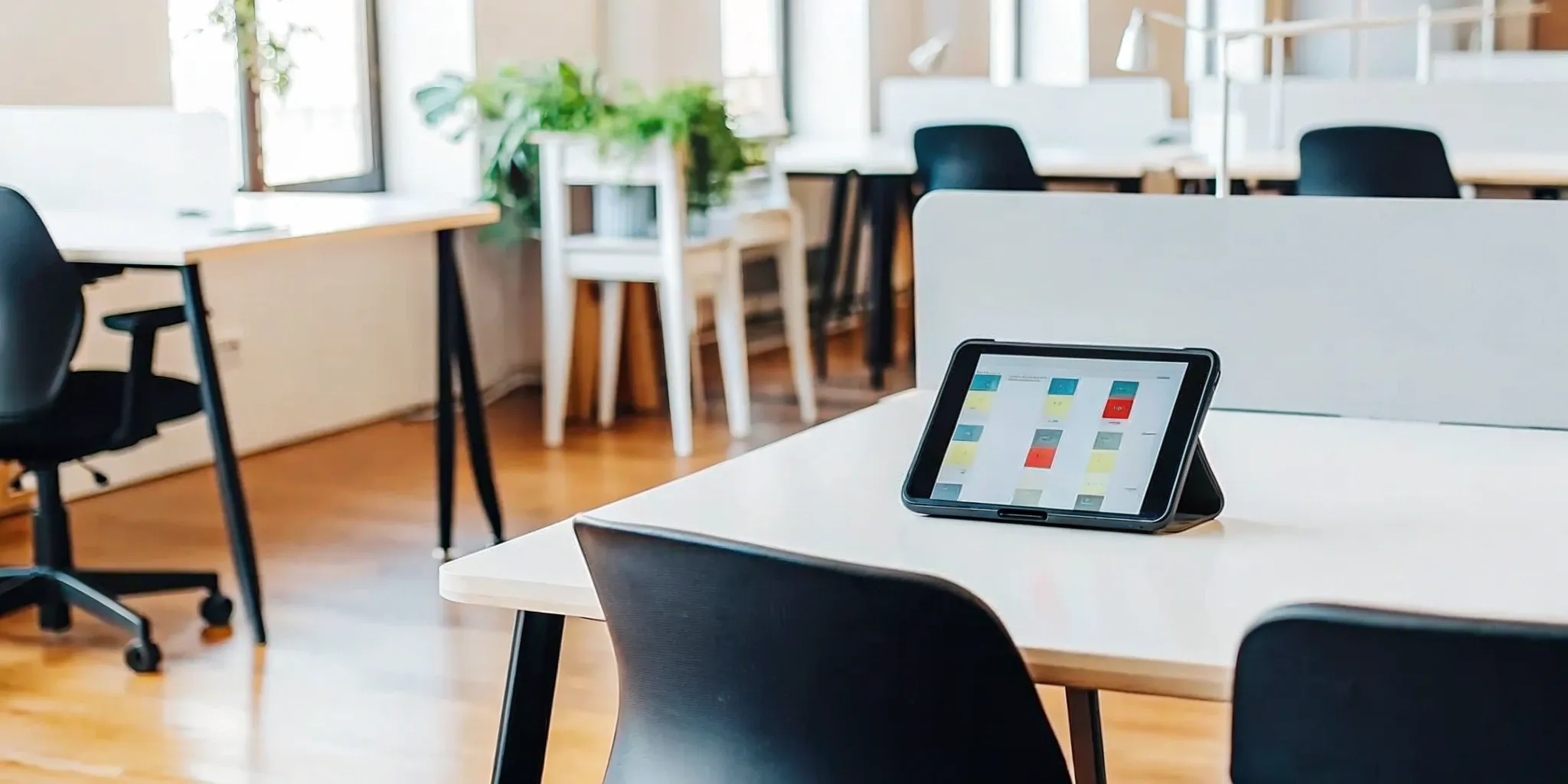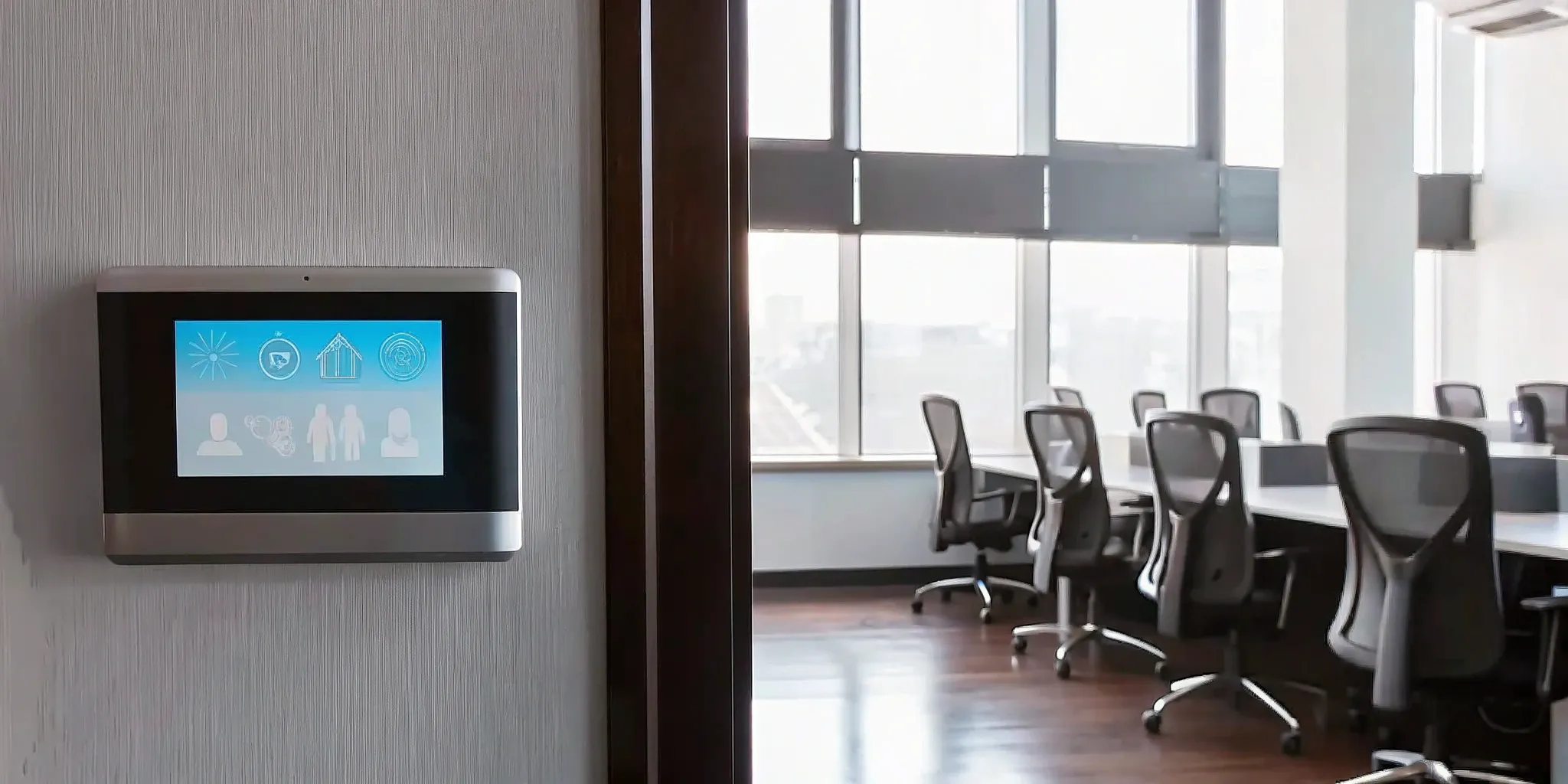You’ve found the perfect desk for the day—it’s near a window and close to your team. But when you arrive, it’s covered in someone else’s coffee rings and crumbs. Or worse, the desk you booked in advance is still occupied by a laptop and notebook, even though no one is there. These small daily frustrations can quickly undermine a flexible office policy. The success of any desk sharing system relies on more than just software; it depends on a shared understanding of simple etiquette. This guide outlines the essential ground rules that create a respectful, clean, and fair environment for everyone.
Making Desk Sharing Work: Simple Etiquette for Your Hybrid Office
Desk sharing improves office space utilization and supports flexible hybrid work models.
- What it does: Allows employees to choose workspaces and collaborate easily in a shared environment.
- Why it matters: Reduces real estate costs, enhances team collaboration, and maximizes office space.
- Key benefit: Promotes employee flexibility and boosts productivity.
- Who it’s for: Ideal for companies adopting hybrid work, looking to optimize office layouts and foster collaboration.
- Best practice: Define clear desk sharing policies and use efficient booking tools like Officely for smoother operations.
What is Desk Sharing?
Desk sharing is a workplace strategy where employees don’t have assigned desks. Instead, they use a different desk each time they come into the office, often booking it in advance. This approach is a cornerstone of the modern hybrid office, designed to accommodate a workforce that isn't physically present every day. By letting go of the one-person-per-desk model, companies can create a more dynamic and efficient office environment. It’s less about claiming a permanent spot and more about finding the right space for the work you need to do on any given day, whether that’s a quiet corner for focused tasks or a collaborative hub for team projects.
A Clear Definition of Shared Desk Offices
At its core, a shared desk office is one where employees reserve a workspace for the day rather than having a permanent one. As the team at Joan Workplace puts it, "Desk sharing means employees don't have their own permanent desk. Instead, they reserve a shared desk each day they come to the office." This model supports flexibility, allowing companies to optimize their real estate based on actual daily attendance instead of headcount. It transforms the office from a static collection of individual territories into a fluid resource that adapts to the team's changing needs, ensuring that space is used effectively and purposefully.
Desk Sharing vs. Hot Desking: What's the Difference?
While people often use the terms "desk sharing" and "hot desking" interchangeably, there are subtle differences. Think of desk sharing as the broader category. It can be a structured system where specific desks or zones are reserved for certain teams on a rotating schedule, making it more predictable. Hot desking, on the other hand, is typically more spontaneous. Employees arrive and claim any available desk on a first-come, first-served basis. This encourages mingling between departments but can also lead to uncertainty. Both approaches require a reliable hot desk booking system to prevent morning scrambles and ensure everyone can find a place to work.
The Challenges of Desk Sharing
While desk sharing offers significant benefits for space optimization and flexibility, it’s not without its challenges. Transitioning from a traditional office setup requires a shift in mindset for employees who are used to having a personal, permanent workspace. The feeling of losing a "home base" at work can be unsettling for some, and if not managed with care, it can create friction and anxiety. Acknowledging these potential hurdles is the first step toward creating a system that works for everyone, balancing the company's operational goals with the team's need for comfort, stability, and a sense of belonging in the workplace.
Common Drawbacks for Employees
For employees, the biggest adjustment is often the loss of personal space. As the experts at Officernd note, "Employees might feel they have less privacy or personal space," which can make the office feel less personal. Without a dedicated desk to call their own, some may struggle to feel grounded or connected to the workplace. This can sometimes "affect company culture or how much employees feel they belong if not managed well." The daily routine of finding a desk, setting up equipment, and packing everything away can feel disruptive, especially for those who thrive on consistency and familiarity in their work environment.
The Impact on Employee Health and Well-being
The uncertainty of a shared desk environment can also affect employee well-being. The daily question of "Where will I sit today?" can add a layer of stress to the morning routine. A study published by PMC found that for some, particularly men, "Hot-Desking Offices (no assigned desk)" were perceived as the "most problematic overall for their work environment and emotional health." This highlights the importance of implementing a system that provides predictability and control. When employees can easily book a desk near their team or in a preferred work zone, it reduces anxiety and helps maintain the social connections that are vital for a positive work experience.
How to Create a Desk Sharing Policy That Works
A successful desk sharing system doesn’t just happen; it’s built on a clear, thoughtful policy that everyone understands. The goal is to create a framework that makes the process seamless and fair, removing uncertainty and empowering employees to work effectively. This involves more than just setting rules; it’s about providing the right tools, resources, and environment to support a flexible work model. By focusing on communication, convenience, and employee comfort, you can design a policy that makes desk sharing a positive experience for the entire team, turning potential challenges into opportunities for a more collaborative and dynamic workplace.
Best Practices for a Smooth Implementation
To get started, you need a solid plan. According to Zoapi, it’s essential to "set up clear policies and guidelines so everyone knows how it works." This includes defining how far in advance desks can be booked and what the etiquette is for shared spaces. The right technology is also crucial. You should "use technology to book desks" that is simple and intuitive. For instance, a hybrid work software like Officely that integrates directly into Slack or MS Teams removes friction, as employees can book desks within the apps they already use every day, which greatly increases adoption and makes the whole process feel effortless.
Provide Personal Storage
One of the quickest ways to ease the transition to desk sharing is by giving employees a place to store their belongings. Officernd suggests you "encourage employees to use personal storage solutions to keep their belongings organized and minimize clutter." Providing lockers or personal cubbies gives team members a secure "home base" in the office, even if their desk changes daily. This simple addition helps maintain a sense of permanence and personal space, allowing people to keep essentials like notebooks, chargers, and personal items at work without having to carry them back and forth every day.
Create Different Work Zones
A one-size-fits-all approach rarely works in a dynamic office. Instead, "set up areas for quiet work, team meetings, social breaks, and private phone calls." Creating distinct zones caters to different work styles and tasks. A library-style quiet zone is perfect for deep focus, while collaborative pods with whiteboards are ideal for brainstorming sessions. Having designated areas for calls and video meetings prevents noise from disrupting others. This strategy not only improves productivity but also gives employees the autonomy to choose an environment that best suits their needs for the day, making the office a more functional and enjoyable place to be.
Offer Adjustable Furniture
When multiple people use the same workspace, ergonomics become incredibly important. "Providing adjustable furniture can help accommodate different employee needs and preferences," making the shared environment more comfortable and inclusive. This includes adjustable-height standing desks, ergonomic chairs with multiple settings, and monitor arms that can be easily repositioned. Investing in adaptable furniture shows that you prioritize employee health and well-being. It ensures that everyone, regardless of their height or physical needs, can create a comfortable and safe workstation for the day, which is essential for maintaining focus and preventing strain.
Start with a Trial Period
Rolling out a new desk sharing policy can feel like a huge change, so it’s wise not to go all-in at once. A great way to ease into it is to "start with a 30-day test run and ask employees for their thoughts." A pilot program with a single team or department allows you to identify potential issues and gather valuable feedback before implementing the policy company-wide. This approach makes employees feel like part of the process and shows that their opinions matter. It also gives you the chance to refine your guidelines and make adjustments based on real-world experience.
Communicate Clearly
Ultimately, the success of your desk sharing policy hinges on communication. As the team at Zoapi emphasizes, "Clear communication about policies and expectations is essential for a successful desk sharing environment." Don't just send one email and call it a day. Explain the "why" behind the change, host Q&A sessions, and create an easily accessible document with all the guidelines. Ongoing communication is just as important. Use your internal channels to share tips, reminders, and updates. When everyone is on the same page, the system runs smoothly and fosters a culture of mutual respect.
Essential Desk Sharing Etiquette
A great desk sharing policy sets the foundation, but it’s the day-to-day etiquette that makes it truly work. These are the unwritten—or sometimes written—rules of conduct that ensure a shared space remains pleasant, functional, and respectful for everyone. When team members are mindful of their impact on the environment and their colleagues, it creates a positive atmosphere where people can focus and collaborate effectively. Establishing a clear set of etiquette guidelines helps prevent common frustrations and ensures that the office remains a welcoming space for all, no matter where they’re sitting for the day.
Clean Up After Yourself
This is the golden rule of desk sharing. The guiding principle should be to leave the workspace in a better condition than you found it. As Officernd advises, "Everyone should clean their desk, put away personal items, and reset the space at the end of the day." This means wiping down the surface, throwing away any trash, and returning the chair and monitor to a neutral position. It’s a simple act of courtesy that ensures the next person to use the desk has a fresh, clean start to their day, fostering a culture of shared responsibility and respect.
Book and Cancel in Advance
A reliable booking system is the backbone of desk sharing, and its effectiveness depends on everyone using it correctly. It's important to "encourage employees to book desks in advance and cancel if they won't be using them to ensure availability." Booking a desk guarantees you have a spot, but plans can change. If you decide to work from home or won't be coming in, canceling your reservation frees up the desk for a colleague. This simple habit maximizes office space and prevents "ghost bookings," where desks sit empty despite being reserved, which is a common source of frustration.
Respect Noise Levels
In an open, shared environment, noise can be a major distraction. It's crucial to "be mindful of noise levels and maintain a professional atmosphere in shared spaces." This means using headphones for music or virtual meetings, taking personal calls in designated phone booths or private areas, and keeping conversations at a reasonable volume. If your office has established work zones, be sure to respect them. A quiet zone is for focused work, not for team huddles. Being considerate of those around you helps everyone stay productive and focused throughout the day.
Don't Touch Other People's Things
This might seem obvious, but it’s a critical piece of desk sharing etiquette. You should always "respect other people's belongings and personal space to foster a collaborative environment." Even though the desk itself is shared, the items on it for the day belong to the person using it. Avoid moving someone's keyboard, unplugging their charger, or borrowing their pen without asking. This basic courtesy helps build trust and makes people feel secure, even when they don't have a permanent desk to call their own. It reinforces the idea that while the space is shared, personal boundaries are still respected.
Frequently Asked Questions
How can we encourage our team to embrace desk sharing, especially if they're used to having their own space? The key is to frame the change around the benefits to them, not just the company. Start by clearly communicating the "why" behind the shift—more flexibility, better collaboration, and a more dynamic office. Ease the transition by providing personal lockers so everyone still has a secure home base for their belongings. A trial period with one team can also help work out any issues and show everyone that the system is fair and easy to use.
What's the most important rule for making desk sharing work smoothly? If you only focus on one thing, make it this: leave the desk cleaner than you found it. This simple act of wiping down the surface and clearing away your items at the end of the day sets a standard of mutual respect. It ensures that every person starts their day with a fresh, ready-to-use workspace, which eliminates a major source of frustration and builds a culture of shared responsibility.
Is it better to have a first-come, first-served system or require advance booking? While a first-come, first-served approach can feel spontaneous, it often creates unnecessary morning stress and uncertainty. Requiring advance booking through a simple system is almost always the better choice. It gives employees peace of mind knowing they have a guaranteed spot, allows them to coordinate with their teammates, and helps office managers understand how the space is actually being used.
Our office is pretty open. How do we manage different needs, like quiet focus versus team collaboration? You can solve this by creating designated work zones. Set up a library-rules quiet area for deep focus, a collaborative zone with whiteboards and larger tables for team projects, and a few small booths or rooms for private calls. This strategy empowers people to choose the environment that best suits their task for the day, which reduces noise distractions and makes everyone more productive.
What happens if someone consistently leaves their desk a mess or doesn't follow the rules? It’s best to address this directly and privately, starting with a gentle reminder. Often, people just need to be made aware of how their actions affect others. If the behavior continues, it may require a more formal conversation with their manager. The goal isn't to be punitive, but to reinforce that the desk sharing guidelines are part of creating a respectful and functional workplace for everyone.
Key Takeaways
- Create a policy that anticipates employee needs: A successful desk sharing system requires more than just software. Support your team through the transition by providing personal storage, establishing distinct work zones, and communicating the guidelines clearly from the start.
- Establish clear etiquette for shared spaces: The system's success depends on mutual respect. Encourage everyone to clean their desk daily, cancel bookings they won't use, and be mindful of noise levels to keep the office productive and pleasant for all.
- Choose tools that integrate with your workflow: The easier it is to book a desk, the more likely your team will follow the policy. A system that works within existing platforms like Slack or Teams removes barriers and makes participation feel effortless.











.jpg)



.svg)